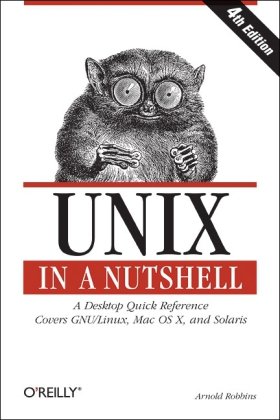
As an open operating system, Unix can be improved on by anyone and everyone: individuals, companies, universities, and more. As a result, the very nature of Unix has been altered over the years by numerous extensions formulated in an assortment of versions. Today, Unix encompasses everything from Sun’s Solaris to Apple’s Mac OS X and more varieties of Linux than you can easily name.
The latest edition of this bestselling reference brings Unix into the 21st century. It’s been reworked to keep current with the broader state of Unix in today’s world and highlight the strengths of this operating system in all its various flavors.
Detailing all Unix commands and options, the informative guide provides generous descriptions and examples that put those commands in context. Here are some of the new features you’ll find in Unix in a Nutshell, Fourth Edition:
- Solaris 10, the latest version of the SVR4-based operating system, GNU/Linux, and Mac OS X
- Bash shell (along with the 1988 and 1993 versions of ksh)
- tsch shell (instead of the original Berkeley csh)
- Package management programs, used for program installation on popular GNU/Linux systems, Solaris and Mac OS X
- GNU Emacs Version 21
- Introduction to source code management systems
- Concurrent versions system
- Subversion version control system
- GDB debugger
As Unix has progressed, certain commands that were once critical have fallen into disuse. To that end, the book has also dropped material that is no longer relevant, keeping it taut and current.
If you’re a Unix user or programmer, you’ll recognize the value of this complete, up-to-date Unix reference. With chapter overviews, specific examples, and detailed command.
Unix in a Nutshell is the standard desktop reference, without question. (Manpages come in a close second.) With a clean layout and superior command tables available at a glance, O’Reilly’s third edition of Nutshell is an essential to own.
Like a dictionary, Unix in a Nutshell helps you find what you need, even if you’re not exactly sure what you’re looking for (or how to spell it!). With that in mind, this book is for intermediate to advanced users only–those new to the Unix operating system would be better off with Learning the Unix Operating System or Unix: Visual Quickstart Guide.
The last full revision of the book was in 1992, and the new edition covers Solaris 7 as well as newer versions of shells (ksh, in particular), RCS, and GNU emacs. Topping off at over 500 pages, Unix in a Nutshell contains–literally–everything you could want to know about the various commands, shells, and functions. Fifty new commands have been added to the already sizable lists, and even the most seasoned user is likely to find a discover a new timesaving command. –Jennifer Buckendorff



